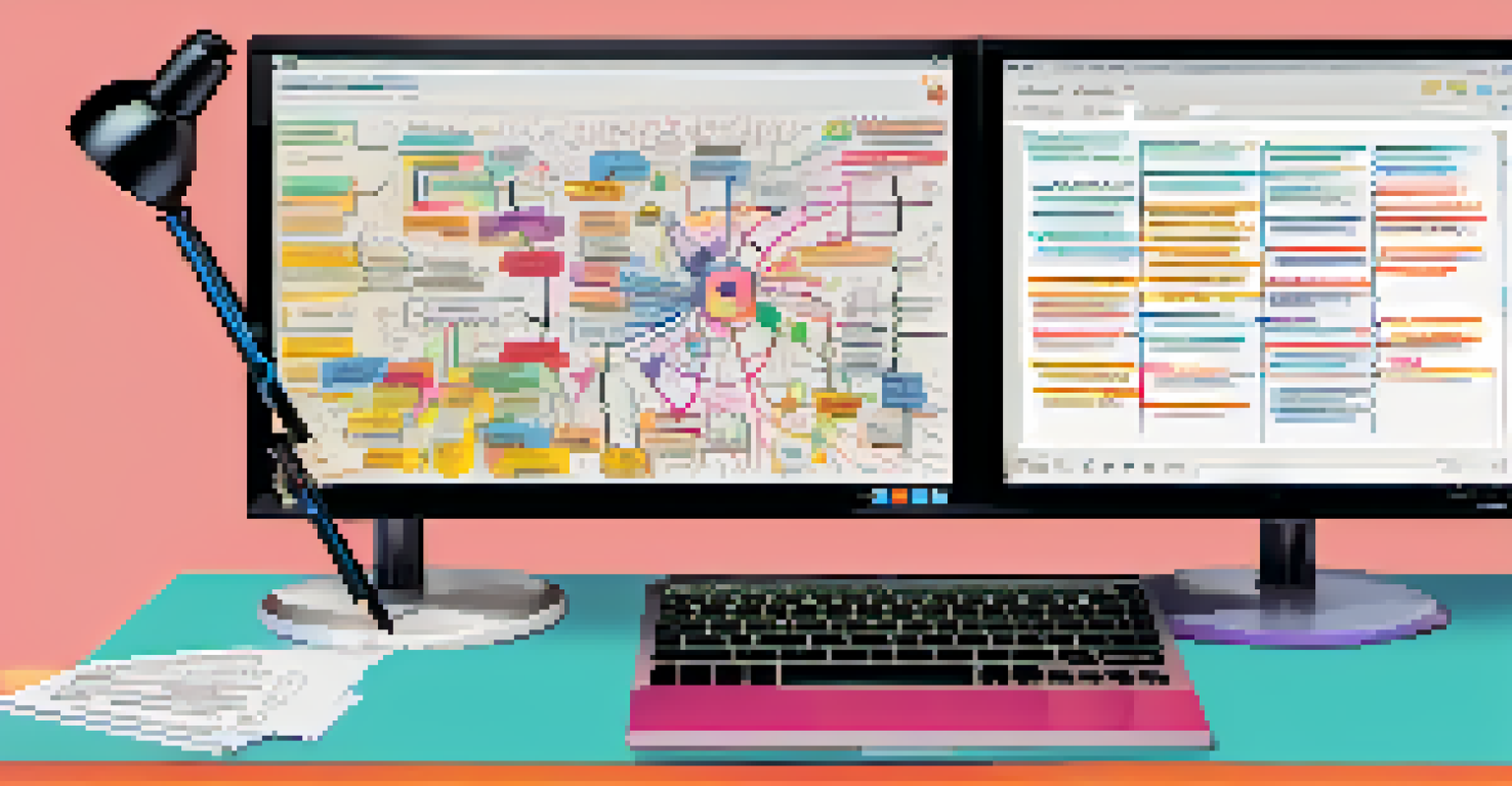Using Collaboration Tools to Enhance Critical Thinking Skills

Understanding Critical Thinking in the Modern Workplace
Critical thinking is the ability to analyze information and make reasoned judgments. In today’s fast-paced work environment, this skill is more essential than ever. It enables individuals to tackle complex problems and come up with innovative solutions.
Critical thinking is the key to unlocking potential and fostering innovation in the workplace.
Often confused with mere problem-solving, critical thinking involves evaluating evidence, recognizing biases, and understanding different perspectives. It’s about asking the right questions and not just accepting information at face value. This deeper level of engagement is crucial for effective teamwork.
As teams collaborate, they bring diverse viewpoints to the table, which can enhance critical thinking. By fostering an environment where questioning is encouraged, teams can harness collective insights to tackle challenges more creatively.
The Role of Collaboration Tools in Critical Thinking
Collaboration tools like Slack, Microsoft Teams, and Trello facilitate communication and idea sharing among team members. They break down barriers, allowing for open discussions that can spark critical thinking. When team members can easily share ideas, they can challenge each other’s assumptions, leading to deeper insights.

These tools often feature discussion forums, file sharing, and task assignments, which keep everyone on the same page. This level of transparency enhances accountability and encourages team members to critically evaluate their contributions. By seeing how their ideas fit into the bigger picture, they can refine their thinking further.
Critical Thinking Boosts Innovation
Critical thinking enables teams to analyze information, evaluate diverse perspectives, and develop creative solutions to complex problems.
Moreover, many collaboration tools include features like polls and surveys, enabling teams to gather feedback quickly. This immediate input can help teams reassess their strategies and make informed decisions, reinforcing the critical thinking process.
Fostering a Culture of Critical Thinking
Creating an environment that nurtures critical thinking requires intention and effort. Leaders can promote this culture by modeling open-mindedness and encouraging team members to voice their thoughts. When employees feel safe to share their ideas, they are more likely to engage in critical analysis.
Diversity of thought is the engine of innovation.
Regular brainstorming sessions using collaboration tools can also help. By setting aside time for free-flowing discussions, teams can explore various angles of a problem. This practice not only enhances critical thinking but also strengthens team cohesion.
Additionally, recognizing and rewarding critical thinking efforts can further reinforce this culture. Celebrating successes that stem from collaborative critical thinking can motivate others to adopt similar practices.
Using Visual Collaboration Tools for Enhanced Clarity
Visual collaboration tools like Miro or Lucidchart can enhance critical thinking by providing a clear framework for discussions. Visual aids help team members see the connections between ideas, making complex information more digestible. This clarity can lead to better, more informed decision-making.
For instance, creating mind maps or flowcharts during brainstorming sessions can help articulate thoughts more effectively. Team members can visually organize their ideas, which promotes deeper analysis and understanding. This approach often leads to innovative solutions that might not emerge through verbal discussions alone.
Collaboration Tools Enhance Engagement
Using collaboration tools fosters open communication and accountability, allowing team members to challenge assumptions and refine their ideas.
Moreover, visual tools facilitate remote collaboration, ensuring that geographical barriers don’t inhibit critical thinking. Teams can collaborate in real-time on visual platforms, allowing for immediate feedback and iterative thinking.
Integrating Asynchronous Collaboration for Deeper Reflection
Asynchronous collaboration tools such as Google Docs and Notion allow team members to contribute at their own pace. This flexibility can lead to deeper reflection and more thoughtful contributions. When individuals have the time to consider their responses, they’re more likely to engage in critical thinking.
Asynchronous discussions can also reduce the pressure of immediate responses, encouraging team members to explore ideas thoroughly. By reviewing and revising their input, they can improve their arguments and insights. This process not only enhances the quality of the output but also promotes a culture of thoughtful dialogue.
Additionally, these tools often track changes and comments, providing a rich history of the team’s thought process. Teams can revisit previous ideas and discussions, which can inspire new approaches to current challenges.
Encouraging Diverse Perspectives Through Collaboration
Diversity in teams can significantly enhance critical thinking. When people from various backgrounds and experiences collaborate, they bring unique perspectives to the table. This variety can challenge conventional thinking and lead to more innovative solutions.
Collaboration tools can facilitate this diversity by allowing team members to share their thoughts without the constraints of a traditional meeting. Features like anonymous feedback or round-robin discussions can help ensure that every voice is heard, encouraging participation from everyone.
Diversity Fuels Deeper Insights
Diverse teams contribute unique perspectives that enhance critical thinking and lead to more innovative solutions through collaborative discussions.
By valuing diverse inputs and encouraging respectful debate, teams can cultivate a richer thought environment. This collaborative approach not only enhances critical thinking but also fosters inclusivity and respect among team members.
Measuring the Impact of Collaboration on Critical Thinking
To truly understand how collaboration tools enhance critical thinking, it’s essential to measure their impact. Teams can assess their progress by evaluating the quality of outcomes and the effectiveness of their decision-making processes. Regular feedback sessions can help identify areas for improvement.
Surveys and metrics can also gauge team engagement and satisfaction with collaboration tools. By asking team members how these tools have influenced their critical thinking, organizations can gather valuable insights to refine their strategies.

Ultimately, measuring success in this area not only highlights the value of collaboration tools but also reinforces the ongoing commitment to fostering critical thinking within the team.